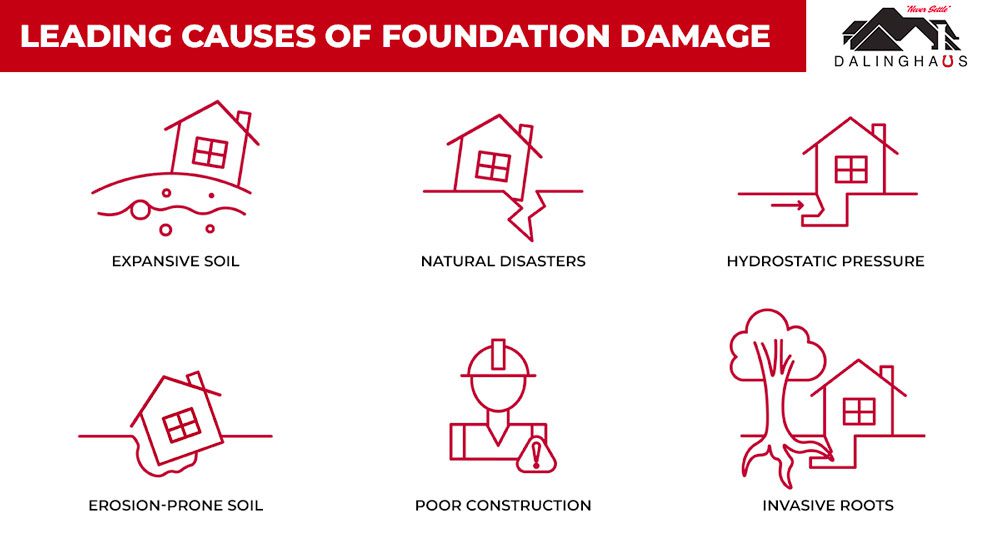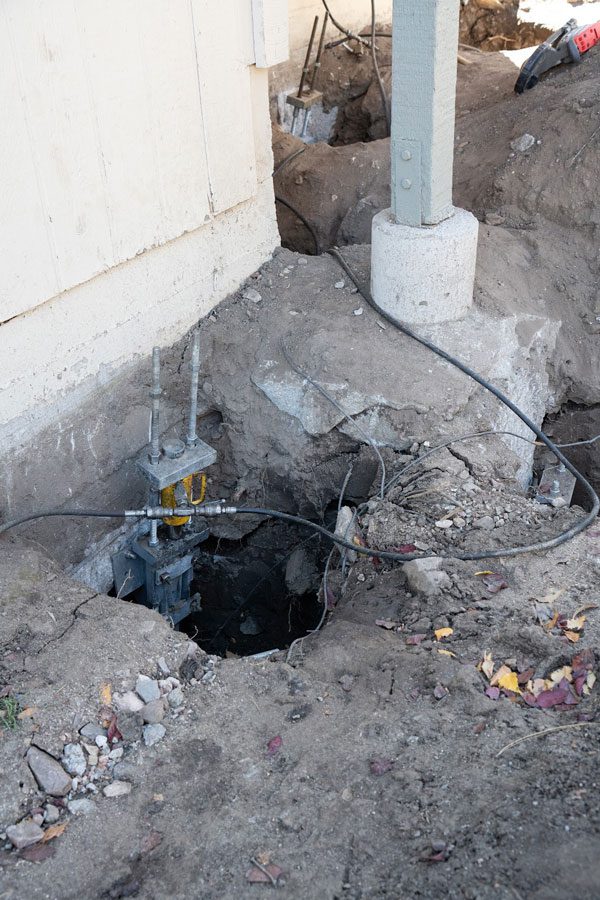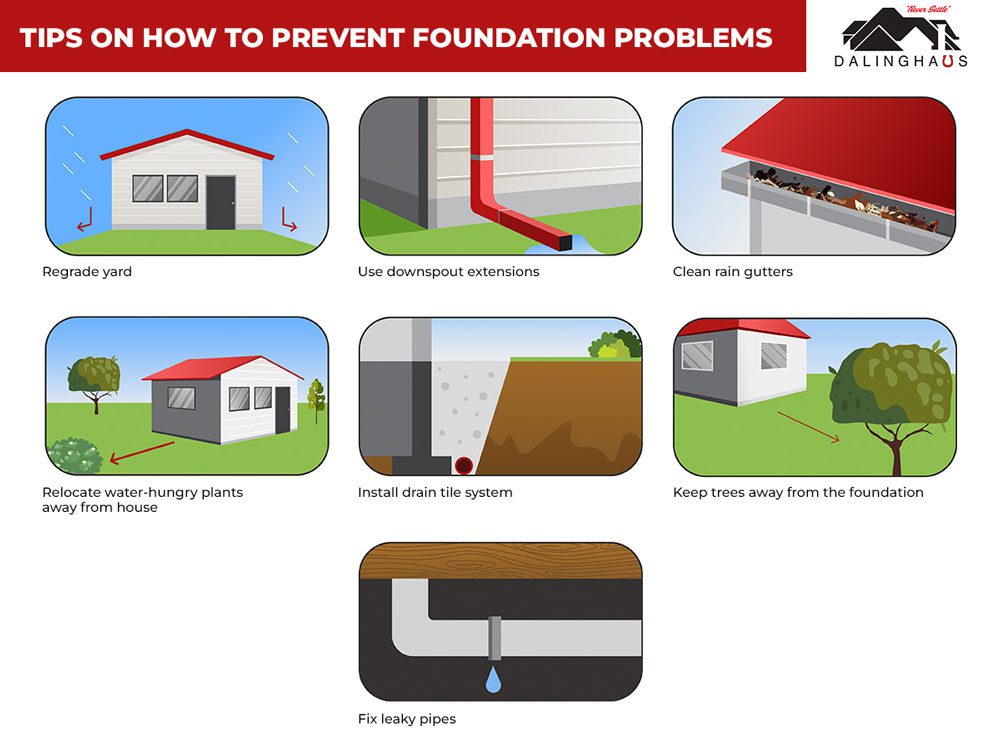You may be at the point where you realize your home needs foundation repairs, but you are hesitant about the process and want to know what to expect. Well, look no further. This article will review what to expect before, during, and after a foundation repair project and why you can trust Dalinghaus Construction with your foundation repair needs.
What Are the Leading Causes of Foundation Damage?
A variety of factors can cause foundation damage, and sometimes simultaneously. The leading causes of damage are related to the oversaturation of the soil surrounding your foundation, but there are other factors, too:
- Poor site preparation – If the soil was not adequately compacted before your home was built, your foundation might settle unevenly, causing foundation damage.
- Erosion-prone soil – Some soil is more susceptible to being carried away by groundwater, creating voids below your foundation and leading to differential settlement.
- Expansive soil – Soil with a high clay content tends to absorb high amounts of water, which causes it to expand. Then, during the hot summer months, the soil contracts as the water evaporates. This cycle of expansion and contraction leads to foundation damage.
- Hydrostatic pressure – When water builds up in the soil around your foundation, perhaps because of poor drainage or frequent flooding, pressure is placed on your foundation walls. This pressure forces water through invisible cracks along your walls, eventually creating larger cracks and bowing the walls.
- Earthquakes – Intense seismic activity can move the soil beneath your foundation, leading to differential settlement and a cracked foundation.
- Invasive roots – Powerful tree roots, even some distance from your home, can create cracks in your foundation or cause the soil around your home to shift, leading to damage.

Why Should I Invest in Foundation Repair?
Your home’s foundation is like the backbone of your home. Any damage to your foundation threatens the structural integrity of your home, and the damage will only worsen over time. Failing to repair your foundation promptly will create more costly home and foundation repairs in the future, reduce the value of your home, and even put your family’s health at risk since damaged foundations are more susceptible to mold growth. When you invest in foundation repair and an efficient maintenance routine, you will have peace of mind knowing that your home and family are safe for decades to come.
What Does a Foundation Inspection Involve?
A foundation inspection is a 60 to 90-minute appointment that involves a Project Design Specialist drawing a digital diagram of your home’s floor plan while taking measurements of your floors’ elevation. The specialist will thoroughly examine your entire home and foundation for any signs of differential settlement and damage. Within 24 hours, you can expect a full report with the specialist’s findings, the scaled drawing of your home, and the recommended foundation repair plan with a cost estimate.
For more details about the inspection process, watch this short video:
What Does the Foundation Repair Process Look Like?
The foundation repair process can be summed up in three phases: Preparation, Repair, and Cleanup.
Preparation

Before any site work is done, we ensure that we attain the required city permits. Once we have the necessary permits, we will schedule the start date. Before work begins, it is crucial to clear the area where work will occur. That includes plants, containers, or furniture to prevent damage. The repair specialists will need clear access to the foundation and room for excavation.
Repair
At Dalinghaus Construction, we will walk you through the repair process. We provide you with a construction timeline and do our utmost to maintain a clean work site. Your foundation repair plan will determine the repair services you will see. Our most common repair services include the installation of push and helical piers to lift sinking foundations, helical tie-backs to stabilize the home and prevent lateral movement, and polyurethane deep injections to stabilize homes before they settle.
Cleanup
Once the installation is complete, we will fill the excavated areas and restore your home to its original condition so that it looks like we were never there.
Dalinghaus offers a lifetime warranty on push and helical piers.
This is what one of our satisfied customers had to say about our seamless repair process:
What Results Should I Expect from a Foundation Repair?
Foundation repairs stabilize your home and provide permanent solutions lasting over 150 years. We offer a 25-year transferable warranty on both materials and labor. However, maintaining the soil around your home is imperative to avoid future damage. The following section will detail some steps you can take to protect your foundation.
When your foundation is lifted, it is essential to note that we lift your foundation to the maximum practical level. In some situations, it is impossible to completely level a building without causing severe cracks and damage. That is why we are careful to raise a sunken home to the maximum practical level so that your home will be stabilized without causing unnecessary damage.
How Can I Prevent Future Foundation Damage?
To prevent future damage, managing the amount of water that pools near your foundation is important to avoid hydrostatic pressure and erosion. Try the following techniques:
- Regrade your yard. – Make sure that the soil slopes away from your home. Sloping the ground will encourage water to flow away from your foundation and prevent flooding.
- Clean your gutters regularly. – Maintaining your gutters will prevent water from spilling over the side of the gutters and soaking into the soil around your foundation.
- Install downspout extenders. – It is essential to divert water at least 10 feet away from your foundation to prevent oversaturation of the soil around your home.
- Choose appropriate landscaping. – Avoid planting shrubs and trees close to your home to avoid two common problems – drying of the soil and overwatering. Plants near your home can dry out the soil, causing it to shrink and potentially causing your foundation to settle and crack. Plants also require a lot of water, which may cause homeowners to overwater and oversaturate the soil, leading to hydrostatic pressure. Instead, consider planting shrubs and trees further from the home and installing a grass barrier to create a path for water to drain.
- Install a drain tile system with a sump pump. – The drain tile and sump pump system will collect excessive moisture in the soil and direct it away from your foundation.

What Comes After the Foundation Is Repaired?
Once your foundation has been repaired, you may notice some small cracks along the walls of your home as your home adjusts to its new position. They are entirely normal and can usually be fixed with caulk or putty. If you have any brick walls, you may need to replace weakened or cracked mortar. If you plan to do any home renovations, such as those involving plumbing, roofing, doors, windows, or flooring, it is recommended to wait two to three months to allow your home to adjust to its new position fully.
Who Should You Choose for Foundation Repairs?
If you need residential or commercial foundation repair in California or Arizona, call Dalinghaus Construction. With over 50 years of combined experience and 350+ foundation repairs, we are fully equipped to stabilize your foundation for decades. Contact us today to schedule your inspection.






